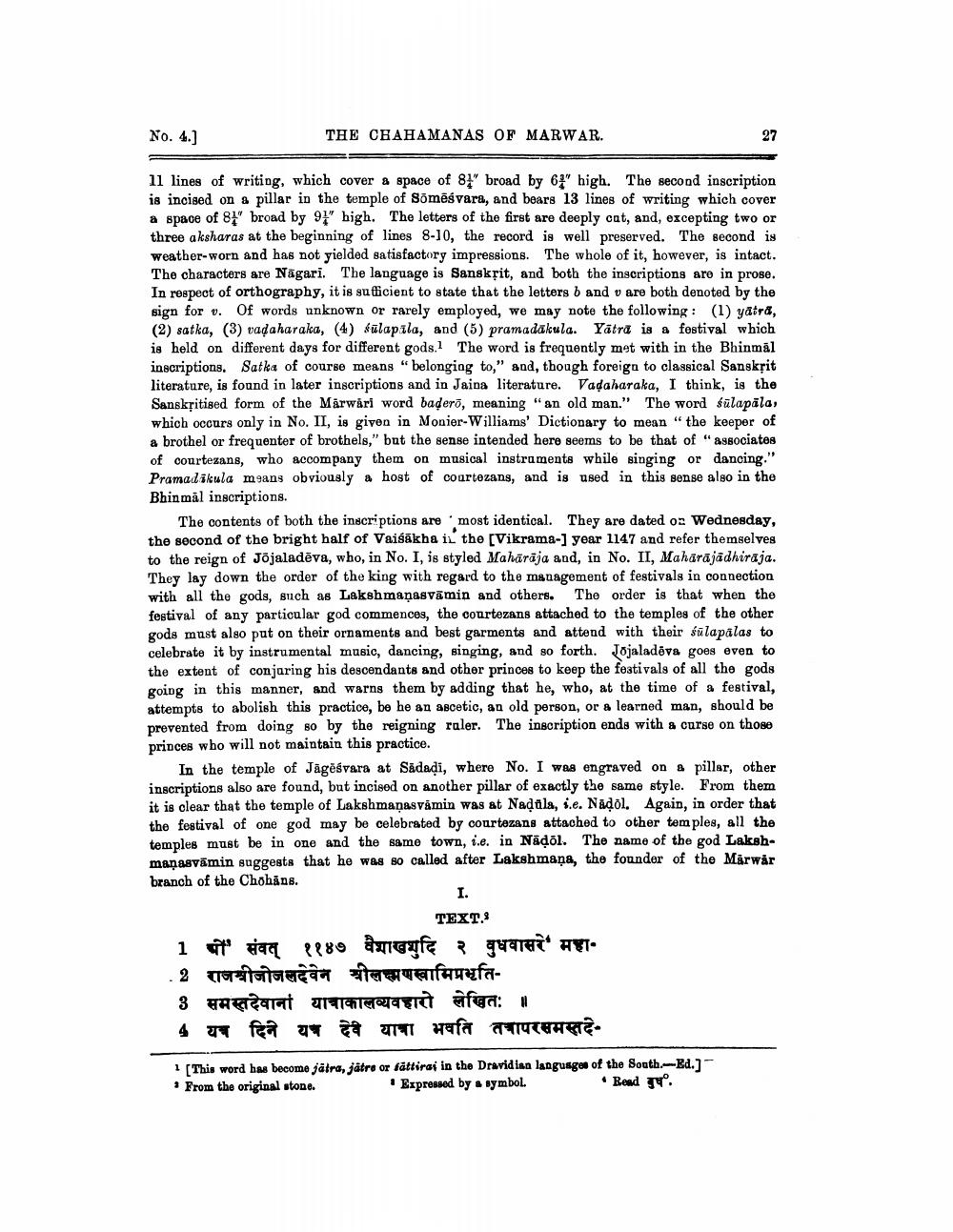________________
No. 4.]
11 lines of writing, which cover a space of 81" broad by 61" high. The second inscription is incised on a pillar in the temple of Sōmesvara, and bears 13 lines of writing which cover a space of 81" broad by 91" high. The letters of the first are deeply cat, and, excepting two or three aksharas at the beginning of lines 8-10, the record is well preserved. The second is weather-worn and has not yielded satisfactory impressions. The whole of it, however, is intact. The characters are Nagari. The language is Sanskrit, and both the inscriptions are in prose. In respect of orthography, it is sufficient to state that the letters b and v are both denoted by the sign for v. Of words unknown or rarely employed, we may note the following: (1) yātrā, (2) satka, (3) vadaharaka, (4) sulapala, and (5) pramadakula. Yatra is a festival which is held on different days for different gods.1 The word is frequently met with in the Bhinmal inscriptions. Satka of course means "belonging to," and, though foreign to classical Sanskrit literature, is found in later inscriptions and in Jaina literature. Vadaharaka, I think, is the Sanskritised form of the Marwari word baḍerō, meaning "an old man." The word sulapāla, which occurs only in No. II, is given in Monier-Williams' Dictionary to mean "the keeper of a brothel or frequenter of brothels," but the sense intended here seems to be that of "associates of courtezans, who accompany them on musical instruments while singing or dancing." Pramadikula means obviously a host of courtezans, and is used in this sense also in the Bhinmal inscriptions.
THE CHAHAMANAS OF MARWAR.
The contents of both the inscriptions are most identical. They are dated on Wednesday, the second of the bright half of Vaisakha in the [Vikrama-] year 1147 and refer themselves to the reign of Jōjaladeva, who, in No. I, is styled Maharaja and, in No. II, Mahārājādhirāja. They lay down the order of the king with regard to the management of festivals in connection with all the gods, such as Lakshmanasvamin and others. The order is that when the festival of any particular god commences, the courtezans attached to the temples of the other gods must also put on their ornaments and best garments and attend with their sulapalas to celebrate it by instrumental music, dancing, singing, and so forth. Jojaladēva goes even to the extent of conjuring his descendants and other princes to keep the festivals of all the gods. going in this manner, and warns them by adding that he, who, at the time of a festival, attempts to abolish this practice, be he an ascetic, an old person, or a learned man, should be prevented from doing so by the reigning ruler. The inscription ends with a curse on those princes who will not maintain this practice.
27
In the temple of Jagesvara at Sadadi, where No. I was engraved on a pillar, other inscriptions also are found, but incised on another pillar of exactly the same style. From them it is clear that the temple of Lakshmanasvamin was at Naḍala, i.e. Nadol. Again, in order that the festival of one god may be celebrated by courtezans attached to other temples, all the temples must be in one and the same town, i.e. in Naḍōl. The name of the god Lakshmanasvamin suggests that he was so called after Lakshmana, the founder of the Marwär branch of the Chōhāns.
I.
TEXT.3
1 ' संवत् १९४० वैशाखमुदि २ बुधवासरे महा
-2 राजश्रीजोजलदेवेन श्रीलक्ष्मणस्वामिप्रभृति
3 समस्तदेवानां यात्राकालव्यवहारो लेखितः ।
4 यत्र दिने यच देवे यात्रा भवति तथापरसमस्तदे
[This word has become jatra, jātre or sättirai in the Dravidian languages of the South-Ed.] From the original stone. Expressed by a symbol.
1
• Read बुध




